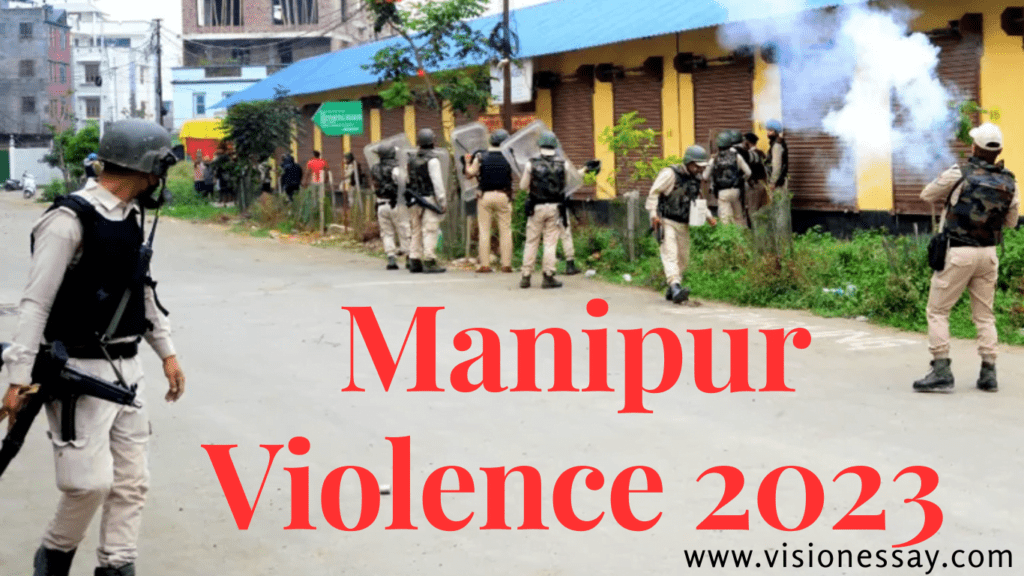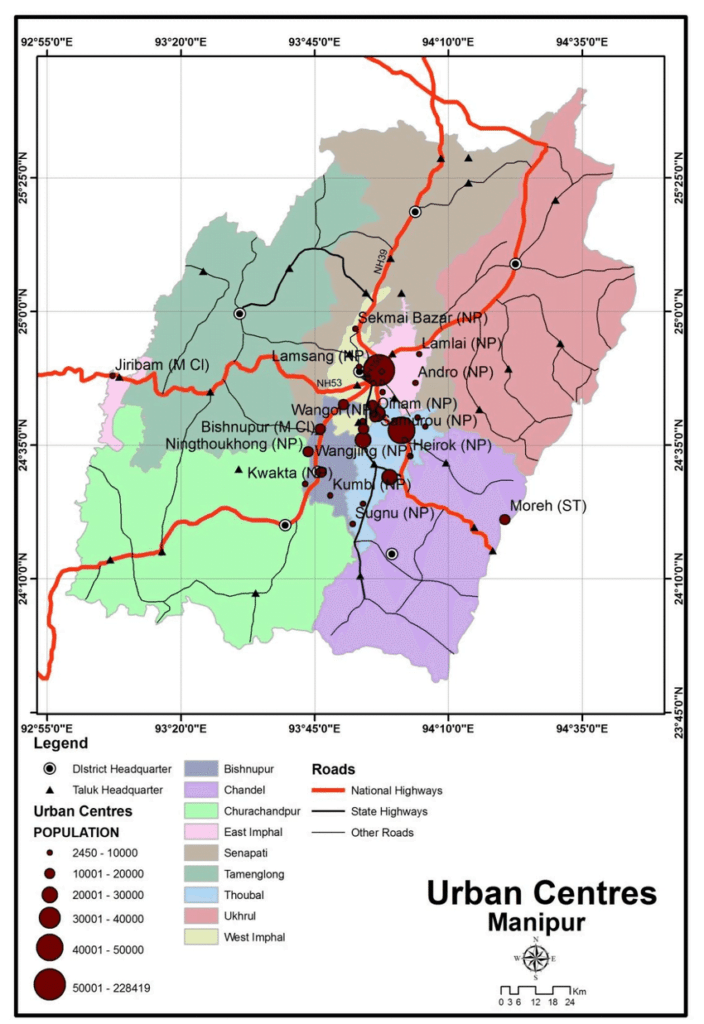
Introduction
Due to the Manipur High Court (HC) ordering the State to follow a 10-year-old recommendation to grant the non-tribal Meitei community Scheduled Tribe (ST) status, there have been deadly intercommunal confrontations in Manipur. After the All-Tribal Student Union Manipur (ATSUM) held a “tribal solidarity rally” against the purported inclusion of the Meiteis on the ST list, the violence intensified.
What’s the historical background of the violence?
- Manipur has 16 districts, however “valley” and “hill” districts are how most people conceptualize the state’s division. The present-day valley districts of Thoubal, Bishnupur, Imphal East, and Kakching were formerly a part of the kingdom of Kangleipak, which was ruled by the Ningthouja dynasty.
- The Chin-Kuki-Mizo-Zomi group, which consists of the Kuki, Thadou, Hmar, Paite, Vaiphei, and Zou peoples and 15 Naga tribes live in the Manipur valley, which is surrounded by low hills (hill lands make up the majority of Manipur’s geographical area).
- Naga tribes that descended from the northern hills frequently raided the Kangleipak kingdom, which was then a protectorate of the British. The Kuki-Zomi were transported from the Kuki-Chin hills of Burma by the British political agent in Manipur in order to serve as a barrier between the Meiteis and the Nagas and defend the valley from looting.
- Kuki-Meitei divide: Since the time of the kingdom, there have been racial tensions between the Meiteis and the hill communities (Naga and Kuki). Insurgencies among the Meiteis and Kuki-Zomi were brought on by the 1950s Naga independence movement. In order to demand a state within India named “Kukiland,” the Kuki-Zomi groups turned militarised in the 1990s. They were no longer friendly with the Meiteis, who they had earlier supported.
- Churachandpur district: Kuki-Zomi-dominated The majority of people of Churachandpur, a district that borders Myanmar, are Christians. According to the Panchayati Raj Ministry in 2006, it is still the poorest district in the entire nation.
What is Ethnic Violence in India’s Manipur?
- The state’s ethnic and geographic split is now the root of the violence that has affected Manipur. In Manipur, 90% of the land is occupied by people who live in the hills and valleys.
- The non-tribal Meitei, who make up more than 64% of the State’s population and produce 40 of the State’s 60 MLAs, are the dominant ethnic group in the valley, which makes up roughly 10% of Manipur’s landmass.
- More than 35% of identified tribes live in the hills, which make up 90% of the area’s landmass, although they only send 20 MLAs to the Assembly.
- While the majority of Meiteis are Hindus, then followed by Muslims, the bulk of the 33 acknowledged tribes—generally categorized as “Any Naga tribes” and “Any Kuki tribes”—are Christians.
What Meitei justification is there for the need for ST status?
- In 2012, the Meiteis were the target of a demand for ST status made by the Scheduled Tribe Demand Committee of Manipur (STDCM).
- Before the State and the Union of India merged in 1949, the Meiteis were designated as a tribe. To “preserve” the community and “save the ancestral land, tradition, culture, and language” of the Meiteis, the ST classification is required.
- The Meiteis claim that the community has been kept out of the hills while the tribal people can purchase land in the “shrinking” Imphal Valley (Meits’ concern is that the creation of Greater Nagalim will cause Manipur’s geographic area to contract).
- The movements of the Naga and Kuki fueled Meitei nationalism. In the 1970s, worries about demographic shifts and the dwindling size of traditional Meitei districts began to emerge.
- In order to prevent outsiders from entering Manipur, an Inner Line Permit (ILP) was required between 2006 and 2012. Fears of a demographic shift were stoked by the Kuki-Zomi’s unrestricted migration over Manipur’s porous border with Myanmar.
- After the permit system was eliminated, Manipur’s population growth rate increased dramatically from 12.8% between 1941 and 1951 to 35.04% between 1951 and 1961 and to 37.56% between 1961 and 1971.
Why do tribal organizations oppose giving Meiteis ST status?
- The Meiteis are highly educated and enjoy a demographic and political advantage. Loss of employment possibilities and the ability to buy land in the hills and drive out the tribal people would result from the Meiteis being granted ST status.
- The Meitei people’s language is listed in the Constitution’s Eighth Schedule, and many of them are eligible for benefits related to their status as SC, OBC, or EWS.
- Despite the fact that tribal areas make up 90% of the state’s landmass, Kukis and Nagas note that the Meitei-dominated Imphal valley receives the lion’s share of its funding and development efforts.
Also Read: What Is China-Taiwan Conflict?
Why did the Violence Start?
- While the recent forest eviction and demands for ST status for Meiteis were among the biggest catalysts, the gap between Meiteis and tribals has grown over the previous ten years on several different issues.
- Issues with the Delimitation Process: The Meitei community claimed that the Census data utilized in the exercise did not adequately reflect the demographic breakdown in 2020 when the Centre started its first separation process for the state in 1973.
- Migration from the Surrounding Area: The February 2021 coup in Myanmar has caused a refugee crisis in northeastern India. Meitei leaders claim that the number of rural areas in the Churachandpur district has suddenly increased.
- The Drug Problem: Some tribal organizations with strong agendas are attempting to undermine the government’s campaign against drugs.
- Poppy fields were destroyed to launch the anti-drug campaign. The Kuki-Zomi of Manipur were “illegal settlers” who grew narcotics on cleared land.
- Recent Violence: The eviction of a Kuki village’s occupants sparked the first violent protest.
- 38 villages in the Churachandpur-Khoupum Protected Forest area (in the Churachandpur and Noney districts) are “illegal settlements” and their occupants are “encroachers (encroaching reserved and protected forests and wildlife sanctuaries for poppy plantation and drugs business”).
- Since Kukis live in the Hill Area, Kuki groups have argued that the survey and expulsion violate Article 371C.
- By Article 371C, the Governor of Manipur must be responsible for the smooth operation of the committee, which shall be composed of members elected from the state’s Hill Areas.
- Under the Manipur Legislative Assembly (Hill Areas Committee) order, 1972, the Hill Area Committee was established at the State level. All state legislators chosen from the state’s hill regions make up the Hill Areas Committee.

What is The Way Forward?
1. It is necessary to assess the requirements for ST status (to Meities) in light of the advice provided by various Committees, including:
- The Lokur Committee (1965) advocated five identification criteria: primitive characteristics, distinctive culture, isolation from the rest of the world, reluctance to interact with others, and backwardness.
- The Bhuria Commission (2002–2004) examined a variety of topics, including the 5th Schedule, tribal land and forests, health and education, the operation of Panchayats, and the situation of tribal women.
- A High-Level Committee (HLC) was established in 2013 to study the following 5 crucial issues pertaining to tribal communities: (1) livelihood and employment, (2) education, (3) health, (4) involuntary displacement and migration, (5) and legal and constitutional matters. The HLC was chaired by Prof. Virginius Xaxa.
2. Increase the level of surveillance in the border regions to stop the influx of migrants from Myanmar. Regional stability and security can be improved by fortifying diplomatic and economic relations with nearby nations.
3. For one to recognize the local residents, it is necessary to maintain the identities of those living near the border. In order to keep calm in the area, negotiated agreement on peace agreements with the neighborhood rebel organization.
4. To improve the region’s human rights condition, AFSPA, the contentious Armed Forces Special Powers Act of 1958, must be repealed. To prevent security forces from abusing their position of authority, the government should make sure that the legal system is just and open.
Conclusion
There has long been a demand for Scheduled Tribe classification, which first became more urgent in 1983 and then again in the 2000s. The recent Manipur High Court decision ordering the state to apply for ST designation for Meiteis was based on safeguarding “ancestral land, tradition, culture, and heritage.”Based on the defense that the community had been classified as a tribe by the colonial authority before the princely state’s union with the Union of India in 1949. However, depicting it in a rigid communal form is truly a sorry state of affairs. The conflict’s dynamism produced numerous problems about perceived dangers among the communities, such as controlling power and resources, ongoing land pressure on the valley, etc.
Frequently Asked Questions (FAQs)
What was the reason behind Manipur violence?
Tensions erupted when Kukis started protesting Meitei’s claims for formal tribal recognition, which they said would increase their already substantial influence on the government and society and allow them to purchase property or settle in Kuki-dominated areas.
What is the problem in Manipur?
The Kuki tribal tribes and the mostly Meitei society have been engaged in ethnic warfare in India’s Manipur state for more than two months. There have been tens of thousands of displaced people and more than 100 fatalities.
What happened in Manipur with a girl?
On May 4, two indigenous women from Manipur had their modesty violated. In full front of the public, they were paraded naked, fondled, and beaten. Today, a horrific video that the culprit shot surfaced and became viral. Hoihnu Hauzel, a journalist who lives in Manipur, stated that this violates all standards of humanity.
Why is Manipur protesting?
The Kuki and Naga tribes, considered to be India’s most impoverished people and inhabiting the highlands of Manipur, began a protest on May 3 against the potential extension of their privileges to the majority Meiteis.
Sources:
- 2023 Manipur violence – Wikipedia
- Yearender 2023: Manipur violence to Balasore tragedy: Biggest news developments this year – India News | The Financial Express
- Ethnic Violence Spirals in India’s Northeastern Manipur State | Human Rights Watch (hrw.org)
- Dozens of Unclaimed Corpses Show That an Indian Conflict Continues – The New York Times (nytimes.com)
- How Manipur violence unfolded: A timeline of events – India Today
- Manipur violence: What is happening and why – BBC News
- Manipur, India: Eleven killed in new bout of ethnic violence | CNN
